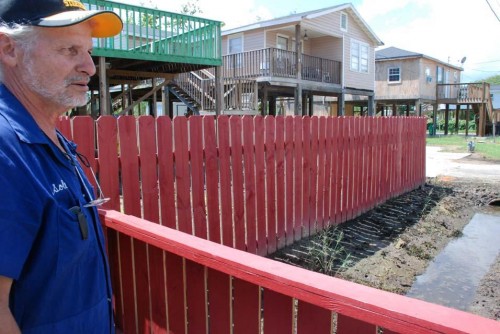
Wilson Pendas
September 18, 2010Tuesday, Sept. 21
September 21, 2010While one side of the road is left high and dry, the residents on the bayou side of Shrimpers Row are not so lucky, and came out to last week’s Terrebonne Parish Council meeting to express their frustrations with recent flooding.
Peter Verdin, a resident of Shrimpers Row, contends flooding occurs when water collects in the drainage ditches in front of the properties along the bayou side of the road. Iron plates placed in front of the cement drains prevent the water from moving out. Even when there’s minimal rain or wind, Verdin says large amounts of water encroaches his property.
“We never used to flood like this,” he said.
And he isn’t the only one with a problem.
“I’ve had it with the flooding,” Mary Verret, a resident of Onezia Street, said at the council meeting. “My house is way up but my yard stays wet. It doesn’t have to be a tropical storm, just rain and southern wind and here comes the water, the mosquitoes, the odor and the dead fish.”
Verret also said her septic tank can’t handle all of the water coming from Onezia Street.
“If we take the plates out and let the water go to the back [toward the opposite side of Shrimpers Row], we’d be high and dry,” Verdin said, adding the water would travel toward the levee and the parish’s forced drainage system where it could then be pumped out.
Before Shrimpers Row was elevated, that’s how water drained, Verdin said.
But according to both Terrebonne Parish President Michel Claudet and Parish Manager Al Levron, since the road was raised, the parish’s forced drainage system in that area calls for plates to be down.
Councilman Clayton Voisin, who represents the area, said culverts – including the plates – were added after the road was elevated.
“In 1995, the designer T. Baker Smith, authorized the raising of Shrimpers Row in multiple phases,” Levron said. “And wanted to create a boundary of that forced drainage system with the installation of gates at each location, and that was the design concept and the permit concept.”
The parish manager said, however, the iron plates are supposed to be reopened once the bayou recedes back to its normal level, according to the operational plan approved by the U.S Army Corps of Engineers.
“The [forced] drainage system was constructed in the late 1970s. In 1977, it was permitted, and another portion was constructed in 1979,” he said. “Any time there were high tides, [it] flooded Shrimpers Row and inundated the drainage system.”
Levron noted plans were for elevating and sealing the drainage system after Hurricane Andrew flooded the coast in 1992.
“This is my district and [flooding] has been a problem for us the last two or three years,” Voisin said. “The road was elevated about six or seven years ago, and the previous administration had allowed the gates to not be closed. If they were closed, [the administration] would open them directly after an event. Now, what [Public Works was] doing was closing the gates and, at night, were actually blocking culverts to make sure the water stayed on the bayou side of Shrimpers Row.”
Voisin said he complained about it to Public Works because it was flooding a majority of the residents that live on the bayou side of the road.
“One side of the road, I mean, it’s almost sickening,” he said. “People are literally cutting their grass, pushing lawn mowers [on one side of the road], and the other people right across the road have water to their knees in their yard.”
But until the operation plan approved by the corps is modified, parish government officials’ hands are tied.
“If I had the opportunity to change that situation I would direct the pump to discharge toward the Houma Navigation Canal instead of Bayou Grand Caillou,” Claudet said. “But we have a system that’s in place and we’re working with what we have.”
Levron also advised against taking any action until the original plan is modified and approved by the corps.
“People on the other side of the bayou expect certain protection,” he said.
Claudet said a Public Works staffer has been tapped to monitor the tides on a daily basis.
“Public Works is looking into a method to assist in that area, but we have a forced drainage system that we basically are protecting at this particular time and operating to the way the corps of engineers is indicating to us to do,” he said.
Shrimpers Row resident Peter Verdin looks out upon the culverts that line Onezia Street and Shrimpers Row. When iron plates are used to cover the culverts the overflow is sent up into yards on the bayou side of the street. JENNA FARMER










